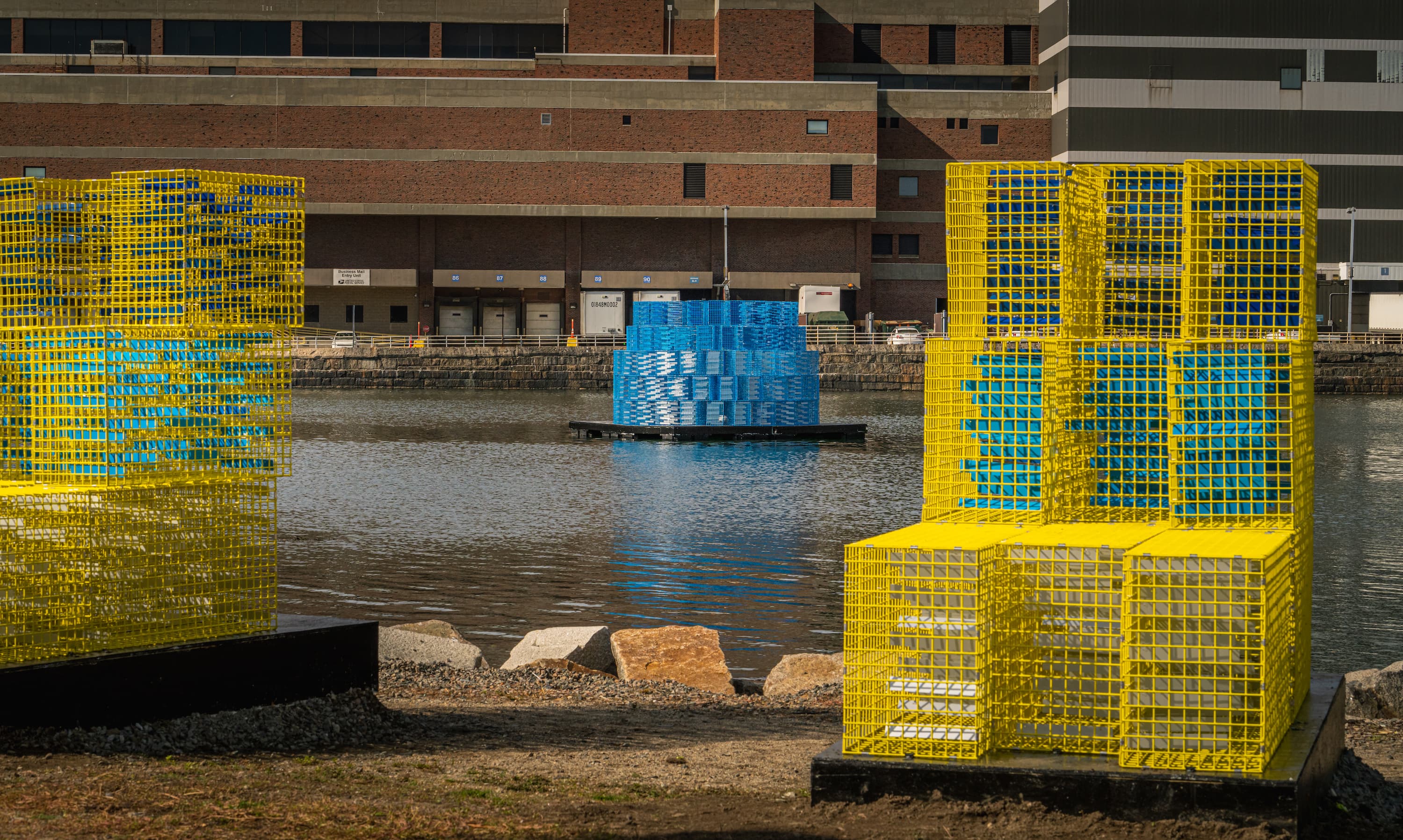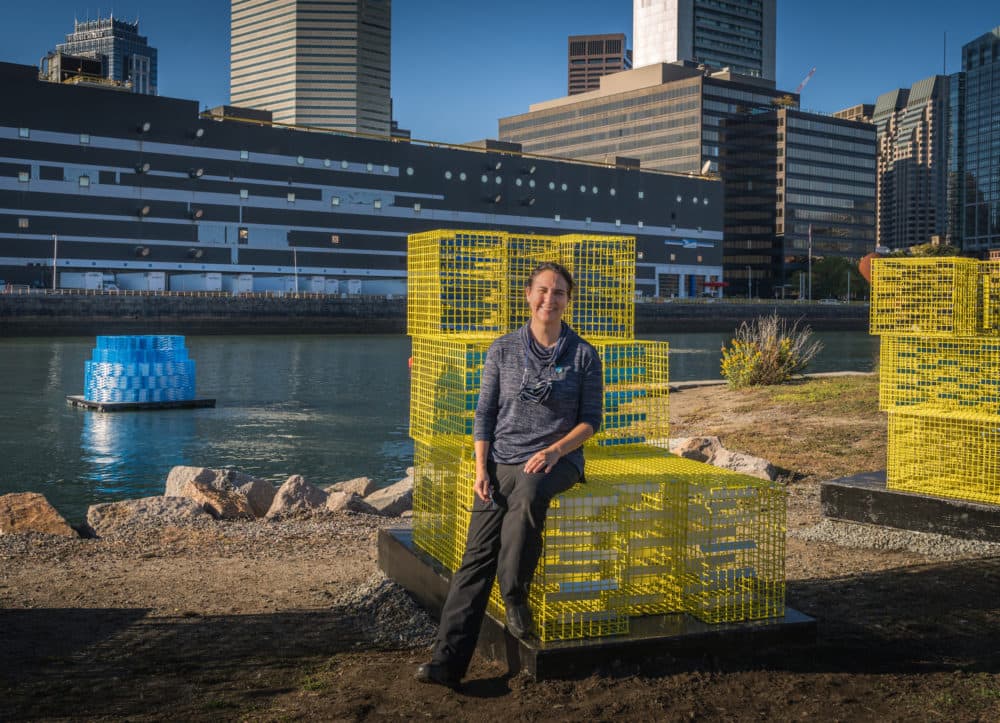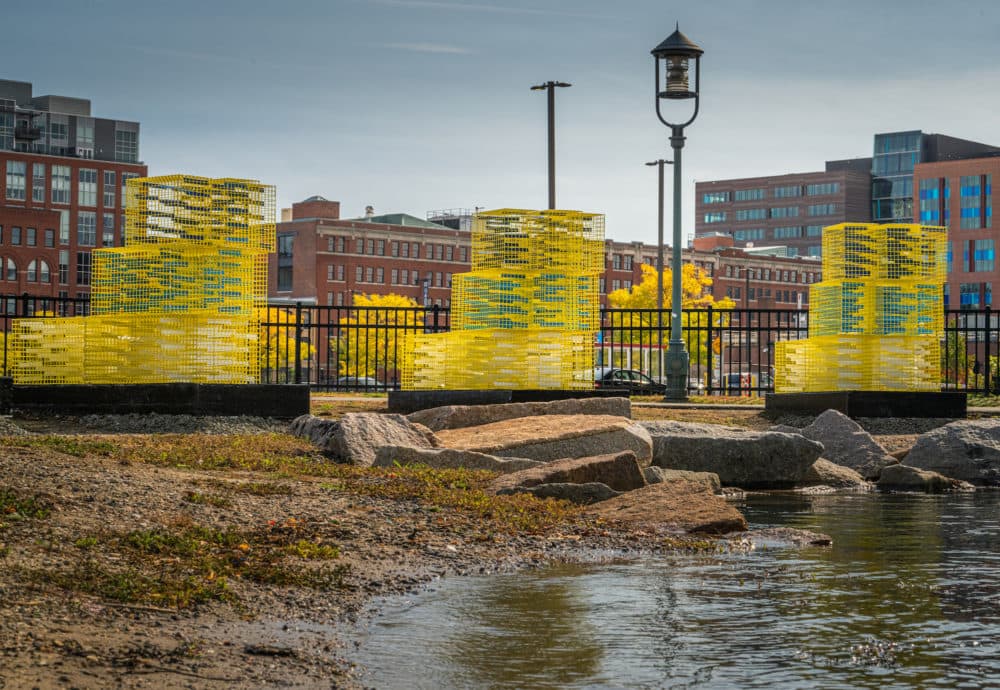Advertisement
Boston Under Water
Fort Point Channel Sculptures Model How High The Water Could Rise In The City

As the Earth’s temperature rises, parts of Boston will be confronted with higher tides that will flood the city's streets, while reaching new watery heights in low-lying areas like parts of South Boston. To help people understand what's happening, artist and University of Massachusetts Amherst professor Carolina Aragón wants to interpret climate change in a more nuanced way, informing the public about the impending realities of a warmer planet.
Aragón created "FutureSHORELINE," a temporary art installation that shows projected flooding in Boston, due to sea level rise. A 10-foot-tall sculpture, made from blue lobster cages, floats in Fort Point Channel. In three tiers, each level represents the projected elevation of sea level rise for the years 2030, 2050, and 2070.
“My artwork has become really focused on visualizing these things in three-dimensional space, in the actual places where this flooding will happen,” Aragón said. “The idea is not that of tricking, but of doing this in a way that allows all of us to hold that information a little bit longer.” Aragón said that responses to climate change will take “a lot of reckoning” and require efforts on individual, urban, societal and environmental scales. Action will demand that citizens ask difficult questions and be able to sit with the discomfort of the initial answers.

The installation also includes land sculptures, made of yellow lobster cages, propped atop the harborwalk. They model how a proposed berm could serve as a wall, blocking the flooding at three different heights, 2.7 feet, 4.4 feet, and 6 feet above land. Funding came in part from Fort Point Arts and UMass Amherst.
The materials for the installation are almost completely Massachusetts-made, with the wire, mesh cages coming from Riverdale Mills, in Northbridge. The traps hold 3,600 aluminum fins, hand-punched with the help of UMass students, and suspended by steel wires and rings. Aragón said these elements are meant to reflect light, like water.
“This is all constructed,” said Aragón. “Climate change is a man-made phenomenon. Shoreline making is man-made. This is definitely at the core of 'FutureSHORELINE.'”
Aragón said that the piece illustrates the daily, seasonal, and exceptional tidal shifts as variables that influence flooding. She wants viewers to understand and process climate change in an immediate, almost physical way. “With 'FutureSHORELINE' you can measure your body against the sculptures and also see the increased amounts of water over the Fort Point Channel. That’s an entirely different way of knowing than what is gained by looking at a diagram, table, or drawing in a book or a map.”
Paul Kirshen of UMass Boston’s Sustainable Solutions Lab helped to provide the scientific research that governs the project, acknowledging that Aragón’s work is highly accurate. The data that he provided her takes all factors that influence flooding into consideration, such as the impact of coastal storms and high tides. To respond to global warming, he said, adaptation will be necessary.

“There are three classic options for managing increased coastal flooding,” Kirshen said. The first way of responding to the threat is to offer protection, by building a berm or wall. The second is to accommodate, letting the flooding occur but elevating buildings to decrease the impact. A third possibility is to retreat, to move away from the coast. While Kirshen says that the city is currently more or less accommodating coastal flooding, a new approach is needed, most likely some form of protection. “The City of Boston has decided that what they want to do, and I think this is a wise approach, is they’re going to essentially elevate the coastline with what we call nature-based solutions, or green infrastructure.”
Aragón said she wants people to engage with the sculpture in their daily lives. Anybody passing by can observe the work and think about the space differently because of it.
“It’s catching you in your natural state,” said Aragón. “For me, I’m always trying to create imaginary landscapes or things that have a life of their own. The outdoors is just ready for it, because there’s changes in life conditions, there’s wind, there’s changes in temperature. It’s just such a dynamic environment. It doesn’t take much to make something kind of magical happen.”
The installation is scheduled to be on display until the end of the summer.
